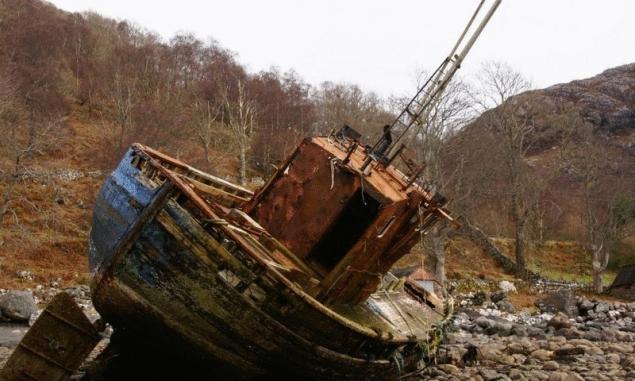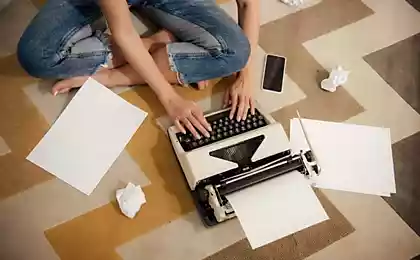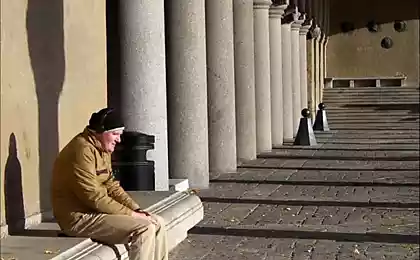163
Stories of hermits in real life
Alexander Selkirk
Alexander Selkirk is considered the prototype of the famous Robinson Crusoe. He spent 4 years and 4 months as a hermit, beginning in 1705. Being a bully, the son of the shoemaker Selkirk was on the note at the church since 1693 because of his indecent behavior. Trying to avoid responsibility to the church authorities, he decided to become a pirate and in 1694 robbed French ships, raided villages in Panama, and deprived merchant ships of their valuable cargo. As an experienced sailor, in 1704 Selkirk was aboard the Cinque Portis, where he expressed concern about the seaworthiness of the ship and informed the captain that he would prefer to be abandoned in the abandoned archipelago of Juan Fernandez. His request was granted, and for the next four years he survived on a clam diet in proud solitude. By the time he was rescued, Selkirk had delved deep into the island, domesticated wild cats to prevent the spread of rats, survived numerous serious wounds and built two huts.
›
Philip Ashton
Philip Ashton became a hermit in 1723 and was alone for 1 year and 4 months. Philip Ashton was busy fishing in the Atlantic when he was captured by Edward Lowe. Lowe, a pirate notorious for his brutality, was described by Sherlock Holmes author Sir Arthur Conan Doyle as a man displaying "amazing and grotesque cruelty." Despite Lowe's barbaric nature, Ashton resolutely refused to cooperate and waited for rescue. Such an opportunity arose in 1723 when his captors stopped at Ruatan Island and Ashton managed to escape into the surrounding jungle. Lacking provisions, Ashton lived primarily on fruit until his path crossed with an English hermit who had been shipwrecked. On guarding the moment, Ashton raided the Englishman's home and, using tools he found, lived for more than a year hunting turtles until he was rescued.

Lindert Hasenbosch
Ascension Island is not a place to call home. With a rocky, volcanic landscape, the island was used until 1815 as a place of exile for criminal sailors. The most widely known of these criminals, Lindert Hasenbosch, was convicted of homosexuality in April 1725. A month later, in May, Hasenbosch was taken to the rocky shore of the island and left here with a tent, a meager portion of water, a handful of seeds, some clothing and writing supplies. The island did not provide him with a source of fresh water, and Lindert drank animal blood and urine in despair. Although his body was never found, Hasenbosch's letters indicate that he survived six months on an inhospitable land where, plagued by imaginary demons, he eventually died of thirst.
Oguri Yukichi
One of the first Japanese to arrive in the Americas, Oguri Yukichi was born for the ocean. At the age of 15, he became a member of the cargo ship crew and 14 years later was promoted to the position of skipper of the ship Tokujomaru. The ship and its skipper did not get along literally from the beginning. In November 1813, the helm and mast of the ship were badly damaged by a storm off the Japanese coast. The ship drifted aimlessly within the Pacific Ocean for 484 days. By the time the team was rescued off the coast of California, only Yukichi and several other men were alive.
Juana Maria
The leader on this list, Juana Maria, survived 18 years of hermitage after being shipwrecked off the coast of California in 1835. After otter hunters wiped out most of the Native Americans inhabiting San Nicolas Island, a rescue operation was sent to gather and safely transport the remaining tribe to the mainland. In the turmoil and turmoil of Juana, Maria was left on the island as a secluded heir to the land, earning the nickname “The Lonely Woman of San Nicolas Island.” Although her story seems tragic, those rescued from the island are far worse off. Isolated on the San Gabriel Reservation, the Indians were susceptible to disease, and most died. When she was eventually discovered, rescuers noted that Maria had built herself a shelter from whale bones and made clothes from feathers of native birds.
Joseph Rangel
A week-long vacation by Joseph Rangel and Lorenzo Madrid turned into a nightmare two weeks long when their boat separated from the main ship in 2000. They found themselves on a deserted, rocky island with their guide. They had to eat snails and grasshoppers and drink the remains of the liquid from bottles that washed to the shores of the island. Their first attempt at rescue failed - tired of constant rowing, people exhausted and were nailed back to the island by the current. Their boat was destroyed and Madrid succumbed to exhaustion and thirst and died within days. Finally, Rangel and the guide built a raft of peeled wood and sailed to the northern tip of the island, where they were rescued by a group of fishermen after 13 agonizing days.

Jose Salvador Alvarenga
Jose Salvador Alvarenga left Costa Azul in December 2012. Accompanied by a teenage boy named Ezekiel, Jose got caught in a storm, was disoriented and drifted throughout the following year. Four months later, Ezekiel lost hope, refused to eat, and eventually starved to death. Alvarenga, on the other hand, relied on his religious beliefs and retained hope of salvation. Surviving on a combination of fish, birds and sharks, Alvarenga drank rainwater, or in extreme cases, his own urine to beat thirst. After traveling some 6,000 miles, the fearsome bearded Alvarenga and his ship were nailed to the shore of the Marshall Islands.
Source: lifeglobe.net/
Alexander Selkirk is considered the prototype of the famous Robinson Crusoe. He spent 4 years and 4 months as a hermit, beginning in 1705. Being a bully, the son of the shoemaker Selkirk was on the note at the church since 1693 because of his indecent behavior. Trying to avoid responsibility to the church authorities, he decided to become a pirate and in 1694 robbed French ships, raided villages in Panama, and deprived merchant ships of their valuable cargo. As an experienced sailor, in 1704 Selkirk was aboard the Cinque Portis, where he expressed concern about the seaworthiness of the ship and informed the captain that he would prefer to be abandoned in the abandoned archipelago of Juan Fernandez. His request was granted, and for the next four years he survived on a clam diet in proud solitude. By the time he was rescued, Selkirk had delved deep into the island, domesticated wild cats to prevent the spread of rats, survived numerous serious wounds and built two huts.
›
Philip Ashton
Philip Ashton became a hermit in 1723 and was alone for 1 year and 4 months. Philip Ashton was busy fishing in the Atlantic when he was captured by Edward Lowe. Lowe, a pirate notorious for his brutality, was described by Sherlock Holmes author Sir Arthur Conan Doyle as a man displaying "amazing and grotesque cruelty." Despite Lowe's barbaric nature, Ashton resolutely refused to cooperate and waited for rescue. Such an opportunity arose in 1723 when his captors stopped at Ruatan Island and Ashton managed to escape into the surrounding jungle. Lacking provisions, Ashton lived primarily on fruit until his path crossed with an English hermit who had been shipwrecked. On guarding the moment, Ashton raided the Englishman's home and, using tools he found, lived for more than a year hunting turtles until he was rescued.

Lindert Hasenbosch
Ascension Island is not a place to call home. With a rocky, volcanic landscape, the island was used until 1815 as a place of exile for criminal sailors. The most widely known of these criminals, Lindert Hasenbosch, was convicted of homosexuality in April 1725. A month later, in May, Hasenbosch was taken to the rocky shore of the island and left here with a tent, a meager portion of water, a handful of seeds, some clothing and writing supplies. The island did not provide him with a source of fresh water, and Lindert drank animal blood and urine in despair. Although his body was never found, Hasenbosch's letters indicate that he survived six months on an inhospitable land where, plagued by imaginary demons, he eventually died of thirst.
Oguri Yukichi
One of the first Japanese to arrive in the Americas, Oguri Yukichi was born for the ocean. At the age of 15, he became a member of the cargo ship crew and 14 years later was promoted to the position of skipper of the ship Tokujomaru. The ship and its skipper did not get along literally from the beginning. In November 1813, the helm and mast of the ship were badly damaged by a storm off the Japanese coast. The ship drifted aimlessly within the Pacific Ocean for 484 days. By the time the team was rescued off the coast of California, only Yukichi and several other men were alive.
Juana Maria
The leader on this list, Juana Maria, survived 18 years of hermitage after being shipwrecked off the coast of California in 1835. After otter hunters wiped out most of the Native Americans inhabiting San Nicolas Island, a rescue operation was sent to gather and safely transport the remaining tribe to the mainland. In the turmoil and turmoil of Juana, Maria was left on the island as a secluded heir to the land, earning the nickname “The Lonely Woman of San Nicolas Island.” Although her story seems tragic, those rescued from the island are far worse off. Isolated on the San Gabriel Reservation, the Indians were susceptible to disease, and most died. When she was eventually discovered, rescuers noted that Maria had built herself a shelter from whale bones and made clothes from feathers of native birds.
Joseph Rangel
A week-long vacation by Joseph Rangel and Lorenzo Madrid turned into a nightmare two weeks long when their boat separated from the main ship in 2000. They found themselves on a deserted, rocky island with their guide. They had to eat snails and grasshoppers and drink the remains of the liquid from bottles that washed to the shores of the island. Their first attempt at rescue failed - tired of constant rowing, people exhausted and were nailed back to the island by the current. Their boat was destroyed and Madrid succumbed to exhaustion and thirst and died within days. Finally, Rangel and the guide built a raft of peeled wood and sailed to the northern tip of the island, where they were rescued by a group of fishermen after 13 agonizing days.

Jose Salvador Alvarenga
Jose Salvador Alvarenga left Costa Azul in December 2012. Accompanied by a teenage boy named Ezekiel, Jose got caught in a storm, was disoriented and drifted throughout the following year. Four months later, Ezekiel lost hope, refused to eat, and eventually starved to death. Alvarenga, on the other hand, relied on his religious beliefs and retained hope of salvation. Surviving on a combination of fish, birds and sharks, Alvarenga drank rainwater, or in extreme cases, his own urine to beat thirst. After traveling some 6,000 miles, the fearsome bearded Alvarenga and his ship were nailed to the shore of the Marshall Islands.
Source: lifeglobe.net/























